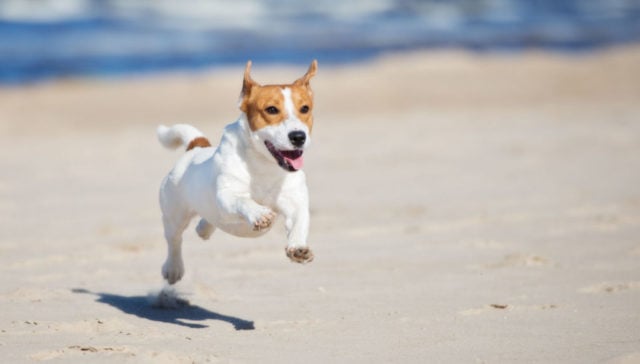
Table of Contents
- Dogs Good for Hot Weather: Understanding Breed Characteristics
- 11 Dogs Good for Hot Weather
- Breeds to Avoid in Hot Weather
- Things to Consider When Outside in the Heat
- Dogs Good for Hot Weather: Conclusion
While dogs are naturally adaptable companions, the climate you live in can significantly influence how comfortable your dog is daily.
The best dogs for hot weather will have the right coat and complimentary body structure suited for the heat.
It’s not entirely surprising that many dog breeds originate from warmer climates with many generations of adaptation, selective breeding, and genetics to suit the environment.
While some dogs are more naturally adept at tolerating warm weather, all dogs will require basic safety measures to ensure they avoid heatstroke on hot days.
For example, never leave dogs in a hot car, even if you park in a shady area.
Provide constant access to fresh water and avoid leaving your dog outside for extended periods.
Dogs Good for Hot Weather: Understanding Breed Characteristics
A breed’s build will tell a lot about a dog’s ability to handle the heat. The most noticeable feature is the coat.
Just as a human wouldn’t want to wear a heavy fur coat in the middle of summer, double-coated or dark-furred dogs aren’t going to enjoy the heat either.
If you’re looking for a dog well-suited for hot weather, look for a pup with short hair, a single coat, or no hair.
Likewise, look for a breed with lighter coloring. Colors like tan, gray, or white will typically do better in the sunshine.
Finally, a dog with a long nose is better suited for warmer weather than short-snouted companions.
The long snout allows the dog to properly process the warm air, cooling it down before it’s breathed into the lungs.
Additionally, dogs with large, erect ears will often cool down quicker than dogs with floppy ears that effectively trap warm air.
Here are a few breeds that typically do better in hot weather, particularly adapted for tropical temperatures:
11 Dogs Good for Hot Weather
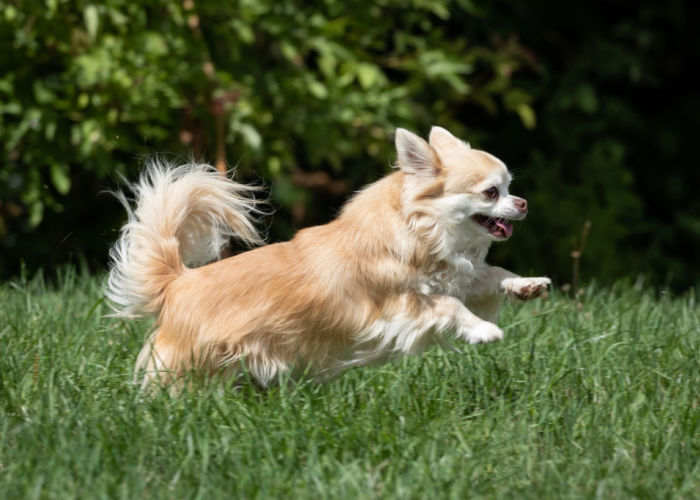
1. Chihuahua
The Chihuahua originates in Mexico’s hot desert, making him no stranger to the heat.
This small breed is a highly adaptable dog that works well in warm weather climates.
The Chihuahua’s thin coat and small size don’t offer much protection against harsh winter environments, so the breed prefers more hospitable climates.
Breed Overview
The Chihuahua is a toy breed weighing between two and six pounds. The pup has a smooth or long coat, available in many colors.
They hold a relatively long life expectancy of 12 to 20 years.
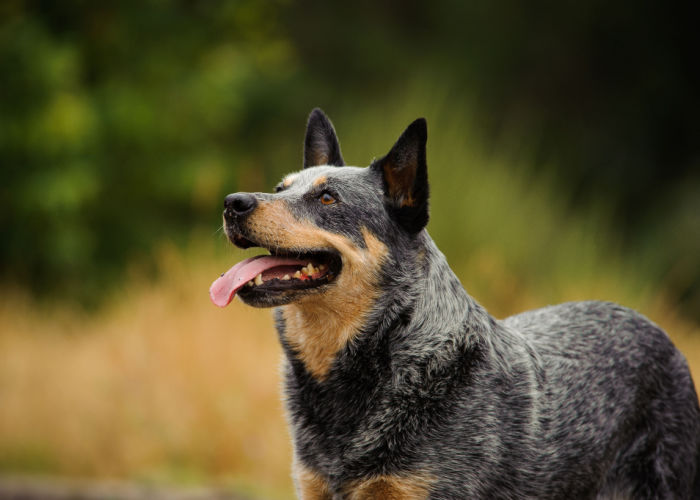
2. Australian Cattle Dog
The Australian cattle dog holds a short double coat, which keeps the heat out on a long day.
It also offers insulation and protection from cooler temperatures. This dog is active, hearty, and driven to work despite the heat or warm temperatures.
The breed is commonly called a “blue heeler” and has a constant flow of energy that never seems to stop (regardless of the weather).
As such, it’s the perfect dog for a warmer climate.
Breed Overview
This breed is found within the herding group, sitting between 35 and 50 pounds. The coat is smooth with blue, blue speckled, or blue mottled mixed in.
Occasionally, there is a red-speckled variety. On average, the Australian cattle dog lives between 13 and 15 years.
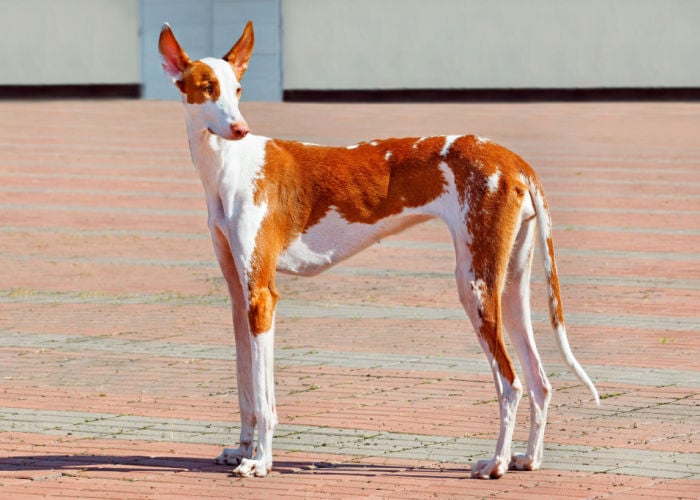
3. Ibizan Hound
This stunning dog originates from the Balearic Islands, near Spain’s coastline.
Researchers believe the Ibizan hound likely descended from Egyptian hounds, initially brought by Phoenician traders.
They are sighthounds, bred to sprint in pursuit of prey under the hot sun. As such, this dog is ideal for warm weather and hot sunshine.
Breed Overview
This dog is part of the hound grouping, weighing approximately 50 pounds.
The dog holds short, coarse hair that can be wiry or smooth. Markings are often solid red, white, or a mixed red and white pattern.
The average life expectancy is between 12 and 14 years.
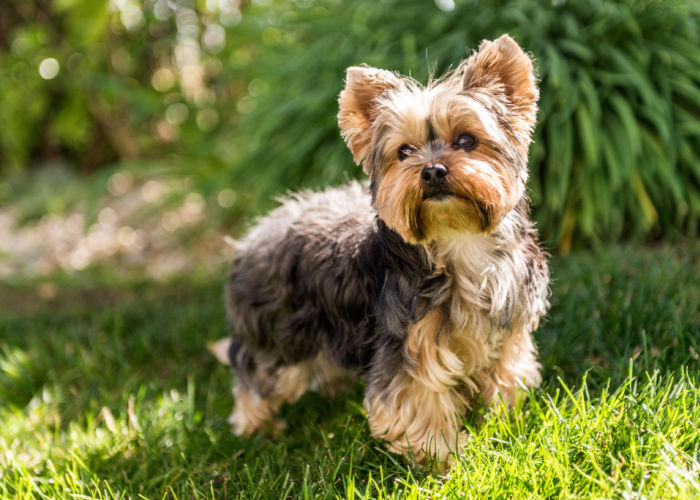
4. Yorkshire Terrier
This little bundle of joy is perfect for warmer temperatures thanks to its long, thin coat.
The thin texture will help the dog from overheating but doesn’t offer much insulation against the cold.
Finally, the coat is hair, not fur. Smaller dogs will often handle the heat better than larger dogs, making the “Yorkie” a fabulous candidate for hot climates.
Breed Overview
The Yorkshire Terrier is a member of the Toy group, sitting between five and seven pounds when fully grown.
They have long, silky, and straight coats that require regular grooming. Color combinations may vary but include black, blue, and tan combinations.
The final coat coloring may not appear until age three or older. The average life expectancy is between 13 and 16 years.
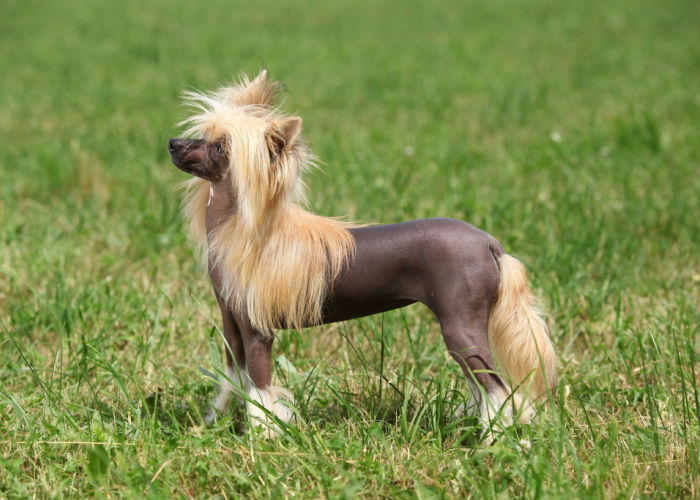
5. Chinese Crested
The Chinese crested dog is predominately hairless. They likely developed in Asia from imported hairless dogs accustomed to hot temperatures.
The exposed skin of a Chinese crested (or any hairless, shorthaired, or sparsely haired dog) can quickly become burnt.
Make sure you apply sunscreen before heading outside to protect your dog from the harmful effects of the sun.
Breed Overview
The Chinese crested dog is a member of the toy group, weighing between eight and 12 pounds.
The Chinese crested has soft and silky hair only covering the head, tail, and feet. The rest of its body is gray-pink skin.
The less popular “powderpuff” variety will have gray and white coloring over the body. The average life expectancy is between 13 and 18 years.
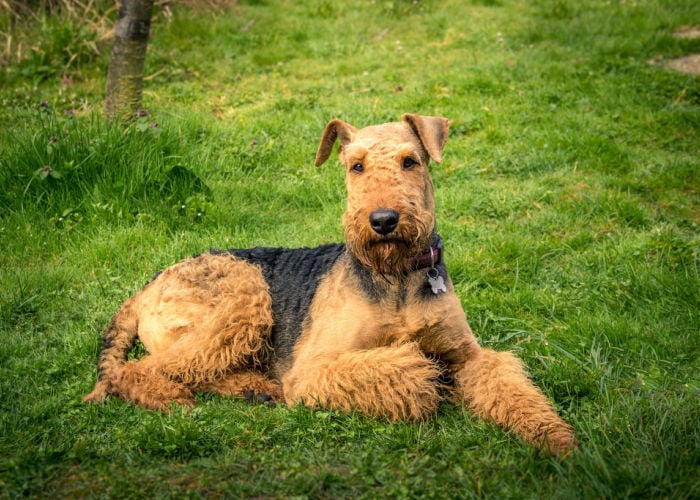
6. Airedale Terrier
The Airedale is the largest of the terrier breeds, sitting as a medium breed dog that tolerates warm weather.
These pups have a fuzzy, wiry coat that is short against the body.
The lack of an undercoat will allow the heat to escape, keeping the dog cool in warm climates.
To improve circulation, have the dog’s coat stripped when the temperature rises.
Breed Overview
This dog is part of the terrier group, weighing 40 and 65 pounds. The Airedale terrier has a wire, hard, dense coat.
The breed’s undercoat is much softer, allowing air to circulate throughout.
The head and ears of this dog are tan, with a mix of dark grizzle or black throughout the body.
The average life expectancy is between 11 and 13 years.
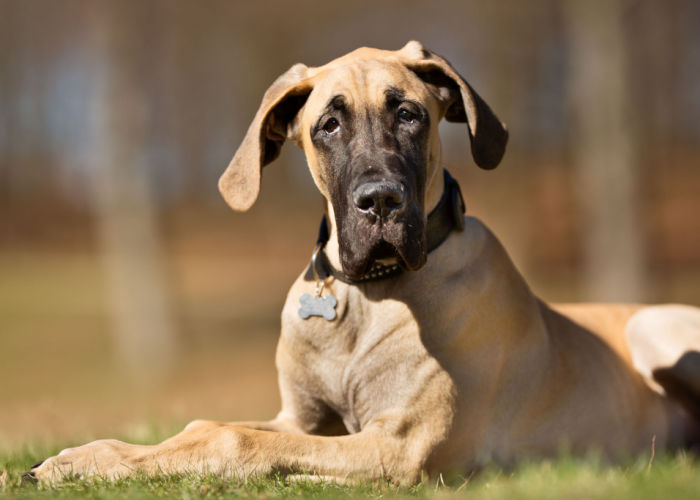
7. Great Dane
The Great Dane is a large breed of dog that does well in hot weather.
They naturally tend to conserve energy, making them couch potatoes when the weather is warm.
The breed tends to prefer living in a warmer climate. If your Great Dane has a dark-colored coat, it can heat up quicker.
Ensure your dog has several shady spots to retreat from the heat, and never leave them outside unattended.
Breed Overview
The Great Dane weighs between 110 to 175 pounds. This breed has short hair in fawn, blue, brindle, mantle, and harlequin coloring.
The average life expectancy is between six and eight years. This giant breed is a member of the working group.
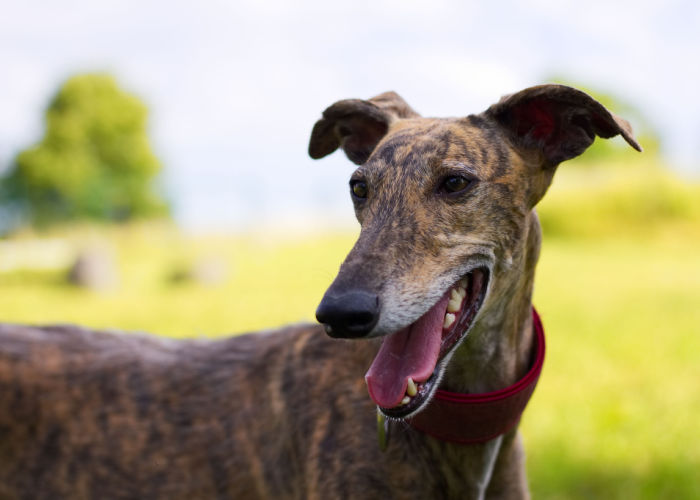
8. Greyhound
Like the smaller Italian Greyhound, the full-size sprinter is ideal for warm summer climates. The Greyhound has a thin, short coat and exceptionally lean body mass.
This breed doesn’t regulate its body temperature well in colder weather.
The Greyhound only needs a few bursts of high-speed activity and the occasional walk, making it ideal for the hot summer environment.
Breed Overview
The Greyhound is a member of the hound group, sitting between 60 and 80 pounds.
The coat is smooth and short, commonly found in black, blue, red, white, fawn, and multiple shades of brindle.
The average life expectancy is between 10 and 13 years.
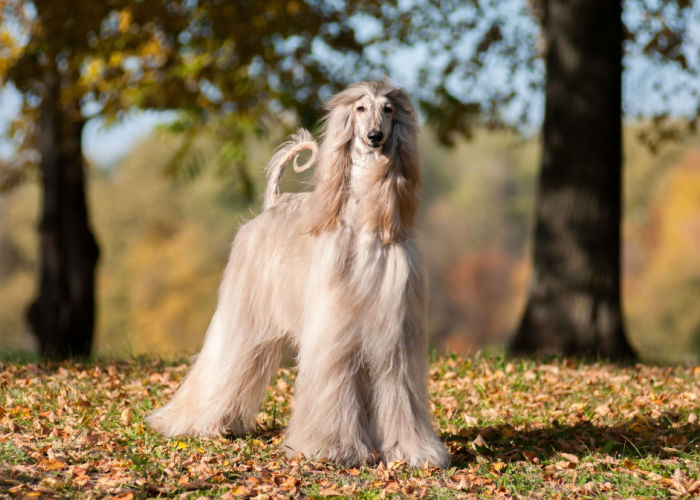
9. Afghan Hound
Don’t let the coat of these large breed dogs fool you; the Afghan hound does well in hot climates.
Despite appearing heavy, the Afghan hound has a single coat of hair designed to keep the dog cool during the day and warm at night.
Unfortunately, these coats are relatively high maintenance, requiring weekly grooming to keep them free of debris and tangles.
The breed’s native homeland is Afghanistan, with fluctuating temperatures between daytime and evening.
Breed Overview
The Afghan hound is a large breed of dog weighing 50 and 60 pounds. They have a long, fine, and thick coat in virtually any color combination.
Coat patterns include domino and brindle patterns. The average life expectancy is between 12 and 14 years.
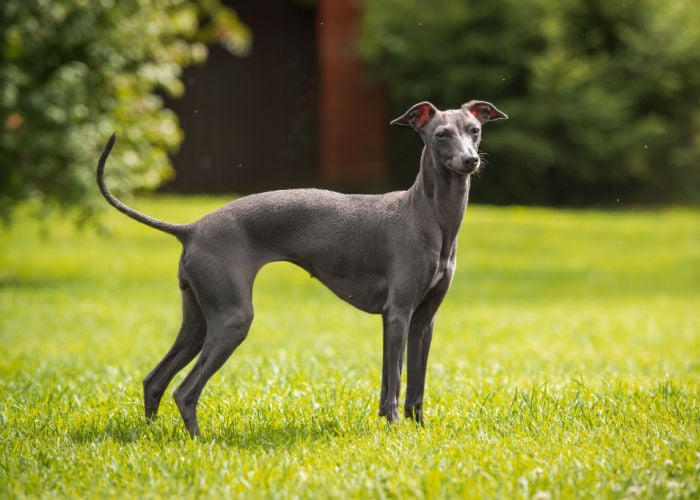
10. Italian Greyhound
This breed is known for its slender frame and thin coat, making them an excellent companion in the summer weather.
The Italian Greyhound will carry very little body fat and often need coats and sweaters to combat the harsh winters.
These dogs feel more comfortable in sunny, warm climates.
Breed Overview
The Italian Greyhound is a member of the toy group, weighing approximately seven to 14 pounds.
They have smooth and short coats in several color combinations. The coat is mostly grey, fawn, black, tan, chocolate, sable, red, or any combination.
The average life expectancy is 14 to 15 years.
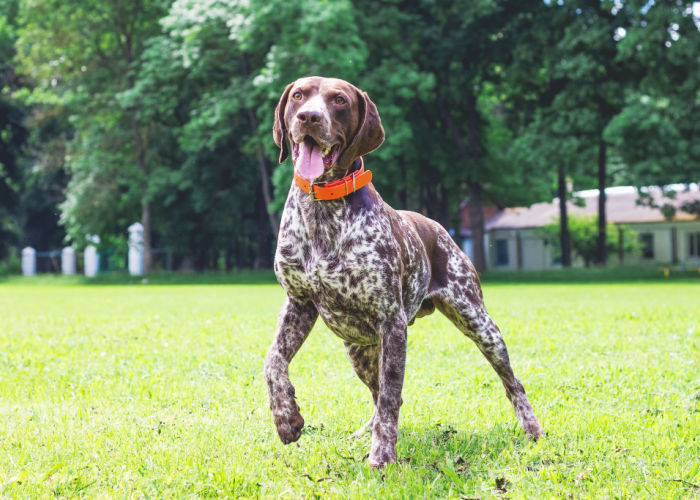
11. German Shorthaired Pointer
Whether you’re looking for active canine companionship or a fantastic hunting dog, the German shorthaired pointer is a perfect pup for hot weather.
These dogs have short fur without an undercoat. This breed loves to swim to cool off, so they won’t hesitate to jump in if given the opportunity.
Always watch these dogs ensure they don’t overexert themselves in extreme heat.
Breed Overview
The German shorthaired pointer is a sporting dog that weighs between 55 and 70 pounds.
These dogs will have a thin, short coat commonly found in the liver and white or solid liver coloring.
The average life expectancy is between ten and 12 years.
Breeds to Avoid in Hot Weather
While many dog breeds will adapt to various conditions, several canines from cold weather locations will likely have a more challenging time adjusting to the heat.
Species like the Alaskan Malamute, Siberian Husky, or Bernese Mountain Dog could become uncomfortably warm in tropical or southern climates.
Dogs with shortened noses or brachycephalic snouts are more likely to overheat in hot weather.
Things to Consider When Outside in the Heat
Dogs shouldn’t reach over 104 degrees, or they may suffer from heat stroke.
Heat stroke can be dangerous, especially if left untreated.
To keep your furry companion cool in hot climates, here are a few things to consider:
Limit Exercise on Hot Days
While you may enjoy the sunshine and heat, your dog may not want their time outside as much.
Always limit exercise to early morning or evening hours on very hot or humid days.
Asphalt gets very hot and can cause burns on the paw, so try to walk your dog on the grass if possible.
Bring plenty of water with you to keep your dog from dehydrating. Be careful with dogs that have white-colored ears, short noses, or no fur.
Don’t Use a Fan
Your dog will respond to heat differently than humans. A dog will sweat primarily through their feet, making cooldown much harder.
A fan won’t cool your dog off as effectively as they might for people.
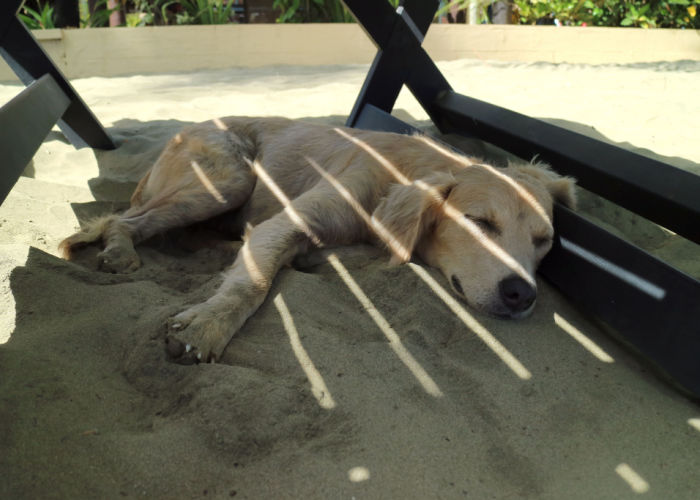
Offer Plenty of Shade and Water
Any time your pet is outside in the heat, ensure they have protection from the sun and access to fresh, cold water.
During heatwaves, consider adding ice cubes to your dog’s water. Tree shade and tarps are ideal for dogs as they don’t obstruct or block airflow.
Most doghouses won’t offer relief from the heat as they trap in warm air and worsen things.
Cool Your Pet Inside and Out
If your dog enjoys baths, rinse them off with a cooling soak to reduce body temperature.
Offer your dog a cooling wrap during heat waves or consider applying cool water to a towel and placing it on the ground for them to lay on.
If you’re spending plenty of time outside, freeze a few treats for your dog to enjoy throughout the day.
Dogs Good for Hot Weather: Conclusion
Although many dogs are adaptable to the heat, a few breeds will do much better long-term than others.
Make sure you find a breed suited to the warm weather, avoiding dogs with thick, heavy coats.
Always offer relief from the outside elements and give plenty of cold water to enjoy.
Additionally, limit outside exercise to early morning or evening hours to keep the dog out of the hottest time of the day.












